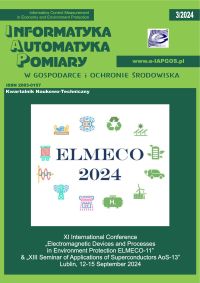ZASTOSOWANIE POTENCJAŁU LENNARD-JONESA DO MODELOWANIA RUCHU ROBOTÓW
Piotr Wójcicki
Politechnika Lubelska (Polska)
http://orcid.org/0000-0002-0522-6223
Tomasz Zientarski
t.zientarski@pollub.plPolitechnika Lubelska (Polska)
http://orcid.org/0000-0002-1693-5316
Abstrakt
W artykule zaproponowano metodę kontrolowania ruchu grupy robotów za pomocą modelu stosowanego do opisu oddziaływań międzyatomowych. Przeprowadzono symulacje metodą dynamiki molekularnej w układzie składającym się z ruchomych grup robotów oraz nieruchomych przeszkód. Zarówno przeszkody, jak i roboty składały się z jednolitych sferycznych obiektów. Oddziaływania między obiektami opisano za pomocą potencjału Lennard-Jonesa. Podczas symulacji, początkowo uporządkowana grupa robotów poruszała się ze stałą prędkością w kierunku przeszkód. Wzajemne zachowanie obiektów modelowano tylko poprzez zmianę wartości parametrów potencjału oddziaływań. Symulacje komputerowe wykazały, że możliwe jest znalezienie optymalnych wartości parametrów oddziaływania, które umożliwiają uzyskanie pożądanego zachowania robotów. W trakcie symulacji uzyskano trzy możliwe warianty zachowania: zatrzymywanie, rozpraszanie i omijanie przeszkód przez grupę robotów.
Słowa kluczowe:
rój, potencjał Lennard¬-Jones, symulacja metodą dynamiki molekularnejBibliografia
Alder B. J., Wainwright T. E.: Phase Transition for a Hard Sphere System. Journal of Chemical Physics 27/1957, 1208–1209, [DOI: 10.1063/1.1743957].
DOI: https://doi.org/10.1063/1.1743957
Google Scholar
Blum C., Merkle D.: Swarm Intelligence: Introduction and Applications. Natural Computing Series. Springer 2008.
DOI: https://doi.org/10.1007/978-3-540-74089-6
Google Scholar
Brambilla M., Ferrante E., Birattari M., Dorigo M.: Swarm robotics: a review from the swarm engineering perspective. Swarm Intelligence 7/2013, 1–41, [DOI: 10.1007/s11721-012-0075-2].
DOI: https://doi.org/10.1007/s11721-012-0075-2
Google Scholar
Engelbretch A. P.: Computational Intelligence, John Wiley and Sons. England 2007.
Google Scholar
Farrelly C., Kell D. B., Knowles J.: Ant Colony Optimalization and Swarm Intelligence. Springer 2008.
Google Scholar
Jones J. E.: On the Determination of Molecular Fields. Royal Society 106/1924, 463–477, [DOI: 10.1098/rspa.1924.0082].
DOI: https://doi.org/10.1098/rspa.1924.0082
Google Scholar
Maxim P. M., Spears W. M., Spears D. F.: Robotic Chain Formations. IFAC Proceedings Volumes 42/2009, 19–24.
DOI: https://doi.org/10.3182/20091006-3-US-4006.00004
Google Scholar
Nouyan S., Dorigo M.: Chain Based Path Formation in Swarms of Robots. ANTS Workshop 2006, 120–131, [DOI:10.1007/11839088_11].
DOI: https://doi.org/10.1007/11839088_11
Google Scholar
Olfati-Saberras R.: Flocking for multi-agent dynamic systems: algorithms and theory. IEEE Transactions on Automatic Control 51/2006, 401–420, [DOI: 10.1109/TAC.2005.864190].
DOI: https://doi.org/10.1109/TAC.2005.864190
Google Scholar
Pinciroli C., Birattari M., Tuci E., Dorigo M., et al.: Self-Organizing and Scalable Shape Formation for a Swarm of Pico Satellites. Proceedings of the 2008 NASA/ESA Conference on Adaptive Hardware and Systems (AHS 2008), 2008, 57–61, [DOI: 10.1109/AHS.2008.41].
DOI: https://doi.org/10.1109/AHS.2008.41
Google Scholar
Shimizu M., Ishiguro A., Kawakatsu T., Masubuchi Y., Doi M.: Coherent Swarming from Local Interaction by Exploiting Molecular Dynamics and Stokesian Dynamics Methods. Proceedings 2003 IEEE/RSJ International Conference on Intelligent Robots and Systems (IROS 2003), 2003, 1614–1619, [DOI: 10.1109/IROS.2003.1248875].
DOI: https://doi.org/10.1109/IROS.2003.1248875
Google Scholar
Son J. H., Ahn H. S., Cha J.: Lennard-Jones potential field-based swarm systems for aggregation and obstacle avoidance. International Conference on Control, Automation and Systems (ICCAS 2017), 2017, 1068–1072, [DOI: 10.23919/ICCAS.2017.8204374].
DOI: https://doi.org/10.23919/ICCAS.2017.8204374
Google Scholar
Stukowski A.: Visualization and analysis of atomistic simulation data with OVITO – the Open Visualization Tool. Modelling and Simulation in Materials Science and Engineering 18/2009, 015012, [DOI: 10.1088/0965-0393/18/1/015012].
DOI: https://doi.org/10.1088/0965-0393/18/1/015012
Google Scholar
Suárez P., Iglesias A., Gálvez A.: Make robots be bats: specializing robotic swarms to the Bat algorithm. Swarm and Evolutionary Computation 44/2019, 113–129, [DOI: 10.1016/j.swevo.2018.01.005].
DOI: https://doi.org/10.1016/j.swevo.2018.01.005
Google Scholar
Sydney N., Paley D.A., Sofge, D.: Physics-inspired motion planning for information-theoretic target detection using multiple aerial robots. Autonomous Robots 41/2017, 231–241, [DOI: 10.1007/s10514-015-9542-0].
DOI: https://doi.org/10.1007/s10514-015-9542-0
Google Scholar
Autorzy
Tomasz Zientarskit.zientarski@pollub.pl
Politechnika Lubelska Polska
http://orcid.org/0000-0002-1693-5316
Statystyki
Abstract views: 463PDF downloads: 255
Licencja

Utwór dostępny jest na licencji Creative Commons Uznanie autorstwa – Na tych samych warunkach 4.0 Miedzynarodowe.
Inne teksty tego samego autora
- Tomasz Zientarski, Marek Miłosz, Marek Kamiński, Maciej Kołodziej, ANALIZA STOSOWALNOŚCI USŁUG SIECIOWYCH TYPU REST I SOAP , Informatyka, Automatyka, Pomiary w Gospodarce i Ochronie Środowiska: Tom 7 Nr 4 (2017)
- Piotr Wójcicki, Paweł Powroźnik, Kamil Żyła, Stanisław Grzegórski, WPŁYW ALGORYTMÓW STEROWANIA ROBOTEM MOBILNYM NA PROCES UNIKANIA PRZESZKÓD , Informatyka, Automatyka, Pomiary w Gospodarce i Ochronie Środowiska: Tom 8 Nr 4 (2018)








